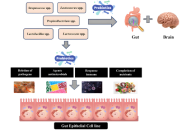142 results in Exploration of Drug Science
Latest
Sort by :
- Latest
- Most Viewed
- Most Downloaded
- Most Cited
Open Access
Correction
Correction: High-risk neuroblastoma stage 4 (NBS4): multi-target inhibitors for c-Src kinases (Csk) and retinoic acid (RA) signalling pathways
Amgad Gerges, Una Canning
Published: January 09, 2026 Explor Drug Sci. 2026;4:1008142

Open Access
Review
Innovative immunotherapies for prostate cancer: understanding the synergies between checkpoint inhibition, CAR T-cell therapy, and next-generation therapeutic modalities
Daniel Kofi Nyame ... Xiaohui Zhou
Published: January 09, 2026 Explor Drug Sci. 2026;4:1008141

Open Access
Original Article
Multiscale computational profiling of a promising carbapenemase inhibitor: from binding dynamics to quantum reactivity
Ayuba Olanrewaju Mustapha ... Yusuf Oloruntoyin Ayipo
Published: January 09, 2026 Explor Drug Sci. 2026;4:1008140
This article belongs to the special issue Discovery and development of new antibacterial compounds

Open Access
Systematic Review
Targeted therapeutic management of diabetes using phytoconstituents: molecular mechanisms, evidence map (2015–2025), and translational outlook
Chizurum Philip Ikegbuna ... Mmesoma Ruth Ikegbuna
Published: January 07, 2026 Explor Drug Sci. 2026;4:1008139

Open Access
Original Article
Novel antimicrobial efficacy on inert surfaces of chlorhexidine-silver nanoparticle veterinary formulation
Daniel Buldain ... Laura Marchetti
Published: January 05, 2026 Explor Drug Sci. 2026;4:1008138
This article belongs to the special issue Discovery and development of new antibacterial compounds

Open Access
Original Article
Binding copper(II) ion released from azo-amino acid Schiff base complex into lysozyme crystals as models for treatment of Alzheimer’s disease
Ayumu Odaka ... Takashiro Akitsu
Published: December 15, 2025 Explor Drug Sci. 2025;3:1008137

Open Access
Original Article
Xymalos monospora leaf extract modulates antidiabetic activity and lipid profile in dexamethasone-induced diabetic rats
Awah Adolf Anguh ... Lifoter Kenneth Navti
Published: December 15, 2025 Explor Drug Sci. 2025;3:1008136

Open Access
Review
Expanding horizon of antimicrobial peptides: mechanistic complexity and biomedical potential
Rahul Kumar
Published: December 09, 2025 Explor Drug Sci. 2025;3:1008135
This article belongs to the special issue Bioactive Peptides: Pioneering Innovations in Latin American Research

Open Access
Letter to the Editor
Further considerations to improve the druggability of biaryl hydroxy-triazole and fluorene-triazole hybrids
Zhiqi Liu ... Zhengwei Huang
Published: November 20, 2025 Explor Drug Sci. 2025;3:1008134

Open Access
Review
Synergism of phages and antimicrobial peptides for treating multidrug resistant bacterial pathogens
Sehrish Nayab ... Muhammad Aamir Aslam
Published: November 12, 2025 Explor Drug Sci. 2025;3:1008133

Open Access
Perspective
Resmetirom and semaglutide in metabolic dysfunction-associated steatohepatitis (MASH): a comparative perspective
Ralf Weiskirchen
Published: October 30, 2025 Explor Drug Sci. 2025;3:1008132
This article belongs to the special issue Innovative Therapeutics in Hepato-Gastroenterology

Open Access
Review
Cedarwood essential oil (Cedrus spp.): a forgotten pharmacological resource with emerging therapeutic potential
Sara Diogo Gonçalves
Published: October 16, 2025 Explor Drug Sci. 2025;3:1008131
This article belongs to the special issue Essential Oils: Insights into Pharmacology, In Vivo, In Vitro and In Silico Studies

Open Access
Correction
Correction: Folic acid conjugated with serum albumin for nano- and submicron delivery systems for applications in therapy and diagnostics
Maria G. Gorobets ... Anna V. Bychkova
Published: September 24, 2025 Explor Drug Sci. 2025;3:1008130

Open Access
Review
Mechanisms of action and health benefits of probiotics: a comprehensive review
Seemi Tasnim Alam ... Md. Aftab Uddin
Published: September 17, 2025 Explor Drug Sci. 2025;3:1008129

Open Access
Review
Tirzepatide in metabolic dysfunction-associated steatotic liver disease and steatohepatitis: a novel star on the horizon?
Amedeo Lonardo, Ralf Weiskirchen
Published: September 04, 2025 Explor Drug Sci. 2025;3:1008128

Open Access
Original Article
Effects of Khaya anthotheca against behavioral disorders and oxidative stress induced by repeated variable stress
Franklin Gamo Zemo ... Dieudonne Njamen
Published: September 03, 2025 Explor Drug Sci. 2025;3:1008127

Open Access
Review
Challenges in drug delivery to the tumors—nanoparticles in medicine
Dorota Bartusik-Aebisher ... David Aebisher
Published: August 19, 2025 Explor Drug Sci. 2025;3:1008126

Open Access
Review
Role of brain cholecystokinin in neuronal homeostasis: rediscovering novel functions of an old neuropeptide
Santiago J. Ballaz
Published: August 18, 2025 Explor Drug Sci. 2025;3:1008125

Open Access
Review
Shaping the healthcare of tomorrow: gene-based medicine as a transformative frontier
Ralf Weiskirchen
Published: August 11, 2025 Explor Drug Sci. 2025;3:1008124
This article belongs to the special issue Advances and Innovations in Gene-Based Medicine

Open Access
Original Article
Canna indica silver nanoparticles (AgNPs): a green alternative for medicine
Mathivathani Kandiah ... Ominda Perera
Published: August 05, 2025 Explor Drug Sci. 2025;3:1008123
This article belongs to the special issue Greening Drug Manufacturing for a Sustainable Healthcare

Journal Information
 Previous
Previous